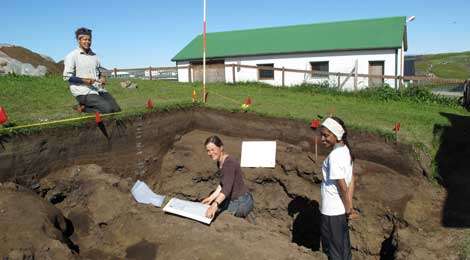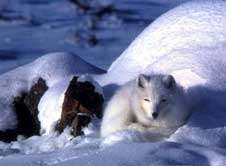Ancient bones reveal paths of arctic fox migration

(Phys.org)—Doctoral faculty and graduate students in archaeology in the GC Anthropology Program have collaborated with an international team of geneticists and biologists in a study of the arctic fox in Iceland.
Arctic foxes were the only land mammals on this mid-Atlantic island prior to colonization by Viking Age settlers around AD 850. CUNY teams extracted ancient DNA from arctic fox bones excavated at Icelandic Viking Age sites, compared it with DNA from the modern Icelandic arctic fox, and learned that a second migration took place, probably during the drift ice periods of the "Little Ice Age" during the seventeenth to eighteenth centuries.
Said Professor Thomas McGovern: "Basically we can prove, using the archaeologically excavated arctic fox bones, that Iceland's Viking Age foxes, who probably came over on sea ice at the end of the Pleistocene Age, were genetically more homogeneous than the modern population in the same area, and that the change is almost certainly due to the ice rafting of new foxes from East Greenland during the Little Ice Age, when sea ice came back to Iceland." McGovern serves on the doctoral faculty in anthropology, coordinates the subfield of archaeology, and directs the Zooarchaeology Laboratory at Hunter College.
The results of the collaborative study were published online by the Proceedings of the Royal Society B—Biological Sciences on September 12, 2012.

This collaboration among archaeologists, biochemists, and biogeographers provides an example of growing interdisciplinary collaboration linking the natural and social sciences. Serving as sponsor of cross-disciplinary collaboration across the region is the international North Atlantic Biocultural Organization (NABO), which is housed at the GC's new Human Ecodynamics Research Center (HERC).
Also providing support is the NSF Arctic Social Sciences program, whereby CUNY Graduate Center archaeologists have collaborated with Scandinavian, Canadian, and UK partners in many seasons of excavation of Icelandic sites dating from the first settlement down to the nineteenth century. The CUNY GC teams mainly specialize in zooarchaeology, the analysis of excavated animal bones. Thanks to new NSF Arctic Social Sciences Program support, HERC is now doing more collaborative work with a UK Durham University lab.
"I do like this ancient DNA stuff!" said McGovern, who also serves as an associate director of HERC. "And there is a cool story about the genetics of premodern codfish stocks, and the origin and spread of Viking Age sheep and pigs across the North Atlantic, including the Faroes. The Faroese pigs were small, hairy, and had white spots."
More information: doi: 10.1098/rspb.2012.1796
Provided by The City University of New York

















